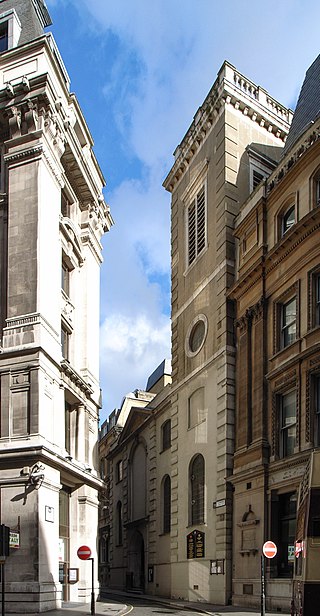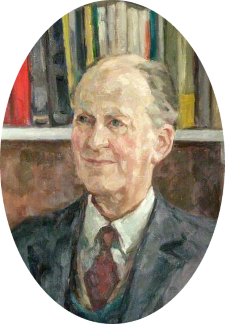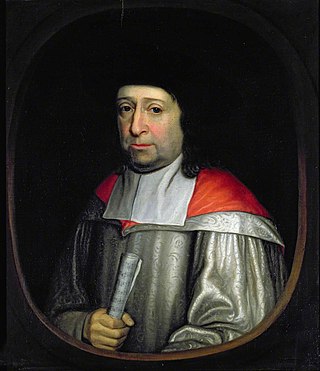Related Research Articles

Henry Purcell was an English composer of Baroque music.

Sir Walter Parratt was an English organist and composer.

St Clement Danes is an Anglican church in the City of Westminster, London. It is situated outside the Royal Courts of Justice on the Strand. Although the first church on the site was reputedly founded in the 9th century by the Danes, the current building was completed in 1682 by Sir Christopher Wren. Wren's building was gutted during the Blitz and not restored until 1958, when it was adapted to its current function as the central church of the Royal Air Force.

St Clement Eastcheap is a Church of England parish church in Candlewick Ward of the City of London. It is located on Clement's Lane, off King William Street and close to London Bridge and the River Thames.
Jeremiah Clarke was an English baroque composer and organist, best known for his Trumpet Voluntary, a popular piece often played at wedding ceremonies or commencement ceremonies.

The Church of St Margaret, Westminster Abbey, is in the grounds of Westminster Abbey on Parliament Square, London, England. It is dedicated to Margaret of Antioch, and forms part of a single World Heritage Site with the Palace of Westminster and Westminster Abbey.

Jonathan Battishill was an English composer, keyboard player, and concert tenor. He began his career as a composer writing theatre music but later devoted himself to working as an organist and composer for the Church of England. He is considered one of the outstanding 18th century English composers of church music and is best remembered today for his seven-part anthem Call to Remembrance, which has long survived in the repertoires of cathedral choirs.
Edward Francis Rimbault was a British organist, musicologist, book collector and author.
John Reading was an English composer, organist and copyist. His greatest importance lies in his work as a transcriber, arranger, and copyist of a wide variety of music.

Sir Thomas Henry Wait Armstrong was an English organist, conductor, composer and educationalist. He was from a musical family and his early career was as a church and cathedral organist. From the 1920s onwards he was a broadcaster for the BBC giving talks as well as playing.

Sir John Frederick Bridge was an English organist, composer, teacher and writer.

St Michael, Cornhill, is a medieval parish church in the City of London with pre-Norman Conquest parochial foundation. It lies in the ward of Cornhill. The medieval structure was lost in the Great Fire of London, and replaced by the present building, traditionally attributed to Sir Christopher Wren. The upper parts of the tower are by Nicholas Hawksmoor. The church was embellished by Sir George Gilbert Scott and Herbert Williams in the nineteenth century.

Christopher Gibbons was an English composer and organist of the Baroque period. He was the second son, and first surviving child of the composer Orlando Gibbons.
Edward Purcell (1689–1740) was an English organist and composer.
Harvey Grace (1874–1944) was an English musician: a composer, conductor, editor and teacher, best known for the 26 year period he worked as editor at The Musical Times.
Anthony Young was an English organist and composer. He was part of a well-known English family of musicians that included several professional singers and organists during the 17th and 18th centuries.

Sir George Clement Martin was an English organist, who served at St Paul's Cathedral.
John Worgan (1724–1790) was an organist and composer of Welsh descent. He is best known for playing the organ at Vauxhall Gardens, the London public pleasure garden in the mid 18th century.
Francis Pigott was an English Baroque composer and organist.
References
- ↑ Holman, Peter, and Thompson, Robert 'Edward Henry Purcell' in Grove Music Online (ed. L. Macy), <http://www.grovemusic.com Archived 16 May 2008 at the Wayback Machine >, accessed 15 March 2008
- 1 2 Dawe, Donovan 'Edward Purcell' in Organs and Organists of the City of London. Padstow: Dawe. 136.
- ↑ 'Hackney: The Parish Church' in A History of the County of Middlesex: Volume 10: Hackney (1995). 115–122. URL: http://www.british-history.ac.uk/report.aspx?compid=22711. Date accessed: 24 March 2008
- ↑ Humphries, Charles and Smith, William C. (1979) Music Publishing in the British Isles. Oxford: Basil Blackwell. 265.
- ↑ "No. 10115". The London Gazette . 20 June 1761. p. 14.